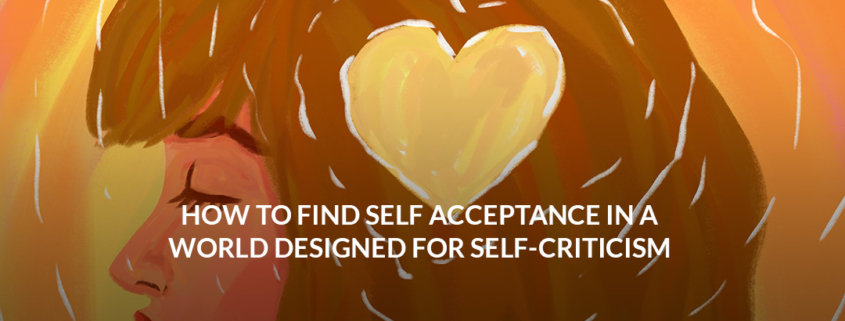How to Find Self Acceptance in a World Designed for Self-Criticism
“You have been criticizing yourself for years, and it hasn’t worked. Try approving of yourself and see what happens.”
~ Louise L. Hay
Let me ask you… do you practice radical self acceptance? I mean the kind of self acceptance that embraces absolutely every aspect of yourself with love, kindness and not one hint of judgment?
If you’re like many people (myself included), total self acceptance is a tall order. It may even seem… impossible. Or… unreasonable. You may think, “Surely there are parts of everyone that are unacceptable. What about bad habits?”
I’m here to tell you that yes, even those parts of you that you believe are unworthy of acceptance are fully, wholly, wonderfully worthy and acceptable. Because they are you.
I want to help you accept yourself. All of yourself. With love, curiosity and compassion. Because full acceptance of ‘what is’ gives you back all that energy you waste on things you really can’t control. That’s when change happens.
There are a few things to unpack before we can do that:
- What true self acceptance is
- How today’s world interferes with full self acceptance
- How our past interferes with full self acceptance
- The parts of all of us that feel unacceptable
So… let’s start unpacking!
What is Self Acceptance?

At its most basic definition, “acceptance” it is simply accepting what is; acknowledging the reality of something. Acceptance matters in many areas of life, especially things we want to change because we can’t truly change anything if we don’t fully accept it first.
When I talk about self acceptance it’s a bit different because it must be self love and acceptance.
True self acceptance means fully accepting all aspects of yourself with unconditional love. This is why I refer to it as “radical” self acceptance. Because truly accepting everything – and I mean everything – really is a radical stance.
It is a fundamental truth that you are good enough exactly as you are. Sure, there may be aspects of your life that you want to shift. Those aspects are good enough as well. Having flaws or areas to improve is not unacceptable. It’s human. And that’s good enough.
I’m guessing that right about now, your mind is swirling with counter-arguments, scanning for examples of things that are not “good enough” or that truly are unacceptable. Let’s keep exploring and see if we can quiet those Gremlins :)
How the World Interferes with Self Acceptance
We humans have always criticized each other. History is one long story of people deciding what is right and what is wrong, then attacking (figuratively or literally) anyone who disagrees or falls short.
Today, our exposure to criticism is at an all-time high thanks to advertising and social media. Think about ads for personal care products, exercise equipment, clothing, cars, housewares, electronics, everything! The message behind most of it is that what you have or who you are isn’t good enough.
When we’re bombarded with these messages, it’s hard not to criticize ourselves. It becomes difficult to see ourselves as good enough, and worthy of acceptance, exactly as we are.
How Our Past Interferes With Self Acceptance
Adults spend more time teaching kids to seek external love, than to love themselves.
Oof. Big feelings with this one. And my intention here is not to drag your parents through the mud. Let’s explore…
Growing up, the adults in our lives likely felt unconditional love for us. But, chances are they didn’t show it, which means we didn’t feel it.
It is so, so, so common for a parent or caregiver to react to things like poor behavior, a failed test, and so on by rescinding love and acceptance. Their reaction may come from fear, their own lack of self acceptance, external pressures, outdated beliefs about what kids need, or they’re simply repeating what their parents did without questioning if that’s really the type of parent they want to be… regardless of where the reaction comes from, the result is a child feeling unloved and unworthy of acceptance.
In this way, many of us grew up conditioned to seek acceptance outside ourselves, and to believe that parts of ourselves truly are unacceptable. When we fail, make a mistake, experience intrusive thoughts, react impulsively, have difficult emotions… we reflexively cut off love for ourselves.
The thing is, love is healing and energizing. Love and acceptance are safe spaces that empower growth, not crutches to weaken us. Let’s say you often get angry at work when things aren’t going well. That angry reaction is coming from a part of yourself that needs to heal. If you cut off love, you cut off healing. You may be able to bottle up your angry reactions, but that just puts you in a cycle of suppression, explosion, suppression, explosion…
If you fully accept that part of yourself with love, you open the lines of healing and energize yourself to grow. To simply notice an angry feeling, without judgment – “There’s my anger. It’s ok. It’s normal, human, welcome and I can move through it.” – is such a healing salve for the soul. It’s in acceptance that new pathways in your mind begin to emerge and old ones gradually begin to lose their influence.
We need to open ourselves up to self love. As parents, friends, leaders, siblings… we also need to be more conscious of our impact so that we don’t continue patterns of rescinding love and acceptance when people need it the most.
The Parts That Feel Unacceptable
Are you not a morning person? Do you bite your nails? Are you often late or rushing to get places? Do you act before thinking? Do you snack when you’re bored? Do you sometimes have intrusive thoughts so “crazy” you wonder if part of you is genuinely bad?

Guess what! All of that is worthy of your acceptance and love.
Why? Because it’s all human.
Every single one of us has parts of ourselves that we struggle with; parts that we believe are unacceptable. When our response is to take love away from those parts, they get cut off from the creative, compassionate, curious parts of ourselves. These parts are meant to work together. It’s like dividing puzzle pieces into two groups – acceptable and unacceptable – then wondering why you can’t make a whole picture out of them.
All parts of you are there. They are your reality. Even the parts you want to change or grow. One of the greatest benefits of self acceptance is that those wounded, unloved parts of yourself get pulled out of the shadow and into the healing light of love, where they can begin to grow into something beautiful.
So… how do you take this and put it into action? How do you actually learn to love and accept your whole self? Like so many other things, it’s about intentional practice; small steps, taken consistently and consciously, building up to a whole new way of being that feels joyful and right to you.
Here Are 7 Ways to Practice Self-Acceptance:
1. Write out 3 things every day that you are proud of.
Have you ever gotten a little note, email or text, either thanking you or recognizing an accomplishment? It feels so good to be valued by others and there’s nothing wrong with that. What’s wrong is that we don’t give this same acknowledgment to ourselves.
 At the end of each day (or whatever time makes sense for you to reflect on the past 24 hours), write down 3 things you feel proud of. It could be as simple as listing 3 things in point form, or more like a note. Something like, “Hey Melissa – You’re doing a great job. I see what’s hard for you and I’m proud of every step you take. Today, you shared your idea in that meeting, drank tea instead of coffee in the afternoon, and read a chapter of your book. I know speaking up was especially scary. Thank you for being so brave.” A lot of people are not comfortable writing a whole note. It can feel cheesy or like they are not being humble. If point form feels most comfortable for you, run with that. The important thing is to acknowledge your efforts and to start generating a mindset of self appreciation.
At the end of each day (or whatever time makes sense for you to reflect on the past 24 hours), write down 3 things you feel proud of. It could be as simple as listing 3 things in point form, or more like a note. Something like, “Hey Melissa – You’re doing a great job. I see what’s hard for you and I’m proud of every step you take. Today, you shared your idea in that meeting, drank tea instead of coffee in the afternoon, and read a chapter of your book. I know speaking up was especially scary. Thank you for being so brave.” A lot of people are not comfortable writing a whole note. It can feel cheesy or like they are not being humble. If point form feels most comfortable for you, run with that. The important thing is to acknowledge your efforts and to start generating a mindset of self appreciation.
Maybe you made a healthy breakfast for your family, spent 5 minutes stretching your body, or had an 8 AM coaching call ;) Whatever you did that day, recognize yourself in writing. This forces you to rewire your brain to focus on what you are doing well and what is working for you, rather than focusing on that endless to-do list and everything that didn’t get done in the day.
As you write, think about how you usually speak to yourself. Are you kind? Do you enjoy your own company? Do you speak to yourself with full acceptance? If not, how can you shift this in your daily life?
Putting pen to paper is a small, yet powerful act. From the first time you do it, you’ll feel a shift towards greater love and acceptance for YOU.
2. Practice flipping the script.
What’s a negative thought you often have about yourself? You know those thoughts or beliefs that hold you back or make you feel like you aren’t good enough? Yes, I’m talking about your Gremlins.Think your negative thought to yourself, then flip it around into a message of acceptance and love. For example, if you recently made a mistake at work, you might be mentalling kicking yourself with thoughts like, “I’m such an idiot. Why did I do that?” Flipping it around may sound like, “I made a mistake because I’m human. There’s nothing wrong with that and there’s nothing wrong with me. What can I learn from this?” There is always something to learn. Focusing on how to grow from something not only helps you develop a growth mindset, it also gives you more to be proud of.Maybe, right this moment, you’re thinking something like, “Self acceptance isn’t for me.” You could flip that around with, “I’ve never tried practicing self acceptance with intention before. I might learn something if I give it a shot.”
At first, practice this in calm moments when you are not feeling triggered. By practicing it in times of peace, you’ll start building new “inner wirings” that will help you treat yourself kindly in times of stress or chaos – those times when you most need self acceptance in order to make choices that honor who you are and what you want for yourself.
3. Practice noticing without judgment.

We learn to judge from a young age. And there’s a place for judgment, for sure. For example, judging if something is truly right for you or not, listening to your intuition to judge if a situation is safe for you, and so on.When it comes to thoughts and feelings, however, judgment suffocates acceptance. Everything that comes up within you is human and, therefore, worthy. None of it is bad. That doesn’t mean all of it is good either. It just… is.Whatever comes up for you, name it, without judgment. This could sound like, “Oh, I’m feeling fear”, “Hmm, I’m criticizing myself,” or “Ah, there’s anger coming up.” Steer clear of labeling yourself (“I am afraid” or “I am angry”). You are not your thoughts and feelings, you are YOU, experiencing things.
If naming things doesn’t work for you, try simply noticing. Visualize thoughts and feelings as clouds in a clear blue sky, drifting in and out. You could even imagine yourself in an airplane, flying above these thoughts and feelings, simply noticing them out the window. There is nothing inherently good or bad about any of them. Even your darkest thoughts are just thoughts. They have no power.
Notice without judgment. Accept their presence. Be open to any messages they may have for you. Then notice as they drift away.
What you’ll find is that none of your thoughts or feelings can actually do anything without your permission. They only gain power when you act on them. Acting can mean following through on a thought, or taking steps to block it out. Using our phones to avoid uncomfortable thoughts, for example, is an action many of us take.
It’s about accepting all elements of your nature. There’s a lovely meditation here about accepting all the elements of you, with love. When you accept thoughts and feelings, you empower yourself to be conscious of which ones you act on and how. The others can simply move on.
4. Practice not taking things personally.
Don Miguel Ruiz’s 4 agreements for life have been hugely influential to me in practicing self acceptance. One that can be the hardest to follow is agreement #2: don’t take anything personally.The way people treat us feels pretty personal. How can we not take it personally?The truth is, how people treat you says far more about them than it does about you. It’s a reflection of their inner experience and their level of self acceptance. One of the many outcomes of self acceptance is that it becomes easier to accept others as they are, because you’re able to recognize them as simply human beings, struggling with human things.
If someone is critical or unkind towards you, it means they are critical or unkind towards themselves. It is a reflection of where they are, based on their upbringing, family, culture, values, stress, and so on. Don’t take it personally. Let that weight slide from your shoulders. It isn’t yours to carry. Send them love (they need it) and move on.
For me, I have a picture of Quan Yin, the goddess of compassion, on my vision board. It is a reminder that everyone has a story. If I knew their stories, I would probably have great compassion for them, so I work to practice compassion in my heart, always assuming that people are doing the best they can with what they have.
5. Practice recognizing love as strength.

Whatever you refuse to accept ends up running your life as you make choices around avoiding triggers. Society feeds this habit by recognizing vulnerability and humanness as weaknesses.The truth is, when you love and accept all parts of yourself, no one else has power over you. No one can influence you with shame, or prey on feelings of inadequacy. You can’t be guilted into saying yes, or get sucked into toxic relationships. Even your own Gremlins won’t be able to keep you in status quo.Instead, you feel empowered to make decisions that align with your values, purpose and vision. You feel confident in your choices and abilities, and in your ability to grow and to handle setbacks.
That is true strength, and it can only come from radical self acceptance.
Practice saying things to yourself like, “When I embrace vulnerability by speaking my truth, I become less vulnerable inside.” “When I let myself feel my emotions and work through them, I’m building resilience.” “When I recognize my efforts and show myself appreciation, I build confidence.”
Another exercise I like to practice is to imagine the unconditional love and light of the sun, the moon and the stars. I visualize it coming down from the sky and pouring onto every part of my body, into every cell entering my DNA. It feels pretty good :-)
6. Put yourself first… especially if you have to put others first.
Wait… what? You might know where I’m going with this if you’re a parent, but this applies to anyone who has responsibility for anyone else. Anyone in a leadership position, for example, has some level of responsibility for the people they lead. You are not responsible for their choices, but you are 100% responsible for how you show up as a leader and the choices that you make.You simply cannot lead effectively if you don’t put yourself first. That means regularly and intentionally connecting within – tuning into your inner leader, values, and purpose, having kind conversations with yourself, and giving yourself time with people and things that truly matter to you, inside and outside work.Focus on doing things that bring you joy intrinsically versus extrinsically, as this fuels your soul and is a way of showing yourself the acceptance and love you deserve.
When you put yourself first, you’re able to make compromises with and for others that actually honor what matters to you, instead of sacrificing pieces of it.
When you aren’t caring for yourself, it’s easier to unintentionally give pieces of yourself away. Without self acceptance, you may feel unworthy of rest or that it’s selfish to take time for yourself. That’s how you end up burnt out and making poor decisions that don’t serve you, your team or the organization.
For parents, what you do and say is a model for your children. If you are always burning out, overextending yourself, feeling exhausted, your children see this. They not only absorb your energy as children, but are likely to take it on as adults because that was their world growing up. If it isn’t something you want for your children, or those around you, why are you doing it to yourself? How you treat yourself will impact those around you. So, why not treat yourself with love?

By practicing self acceptance, you will empower yourself to lead from your heart, and everyone benefits from that.
7. “Fake” it till you become it.
When I talk about changing the way we show up, many people initially feel uncomfortable with the idea. They feel that it’s fake. That it’s insincere, inauthentic, not “them”.I want you to consider this: how you have been showing up isn’t necessarily “you” either. It may be part “you”, but largely, it’s made up of who you’ve been told you are, or who you’ve been told you should be. It’s influenced by things you were told by parents, friends, teachers, caregivers, even celebrities, TV shows, and so on. We spend so much of our early years trying to understand who we have to be to fit into the world around us, and end up losing our true selves in the process.
Confidence and self esteem reflect your level of self acceptance. But that’s a two way street meaning, showing up as if you already have high confidence and self esteem can bolster your inner self acceptance.
In her groundbreaking TED Talk, Amy Cuddy talked about the power of power poses and how holding a power pose has a physiological effect, increasing testosterone (the dominance hormone that makes you feel more confident and in control) and decreasing cortisol (the stress hormone).
Try this:
-
- Begin with a self acceptance pose: Put your left hand over your heart, your right hand over your belly. Take a deep breath and say, “Whatever is happening is okay.” Repeat this until you feel grounded and at ease in the moment.
- From there, go into a self authority pose: Stand with your feet wide and back tall. Place open hands on your hips, lift your chin and gaze ahead. Hold this pose for two full minutes.Notice how you feel. Pretty good, yes? You might think this feeling is fake because you generated it through the poses, but… all feelings are generated from something! The more you practice this, the more it will become a part of you, just as negative, self-deprecating thoughts get repeated within us until they feel like part of us. Turning that around intentionally is self acceptance in action. There is far more information going from your body to your mind than the other way around. When your mind does not “get it”, putting yourself into a different body pose can generate that shift.
Stepping into self acceptance is a powerful and critical part of becoming the CEO of Your Life. When you fully accept and love who you are, right now, with no judgements or conditions, you can finally begin to take authorship of your life and decide for yourself who you want to be and the life you want to create for yourself.
You have had the right to create your life the way you want it from day 1. It’s ok to be influenced by other people or ideas if it is in line with who you truly are and what you truly want. When you allow things that aren’t right for you – or that make you feel less powerful – to determine the course of your life, you are giving up your CEO seat and not honoring the worthiness you were born with. The worthiness that comes simply from being human.
If you would like guidance on practicing self acceptance so that you can step into self authority, I invite you to connect with me.





